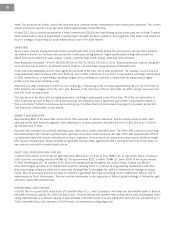Nucor 2011 Annual Report Download - page 21
Download and view the complete annual report
Please find page 21 of the 2011 Nucor annual report below. You can navigate through the pages in the report by either clicking on the pages listed below, or by using the keyword search tool below to find specific information within the annual report.
20 MANAGEMENT’S DISCUSSION AND ANALYSIS OF FINANCIAL CONDITION AND RESULTS OF OPERATIONS
OVERVIEW
MACROECONOMIC CONDITIONS
The sluggish pace of the economic recovery since the worst national recession the United States has experienced in decades
continues to adversely affect our business. Although the U.S. economy has grown since the second half of 2009, the unemployment
rate remains high due to the loss of millions of jobs during the recession and the slow pace of the recovery. In some sectors of the
economy, particularly housing and nonresidential construction, the recovery has been minimal at best. Employment is not expected to
regain the peak reached during the most recent economic cycle for several more years. Until a stronger job recovery takes hold, it is
also expected that consumer confidence and spending will be inconsistent, indirectly negatively affecting demand for our products. In
2011, the economy — particularly the manufacturing and automotive sectors — was negatively impacted by the devastating Japanese
earthquake and tsunami that occurred in March. Uncertainties in Europe’s financial sector and the potential impact on banks in other
regions of the world will continue to weigh on global and domestic growth in 2012. We believe our net sales and financial results will
be stronger in 2012 than in 2011, but they will continue to be adversely affected by these general economic factors as well as by the
conditions specific to the steel industry that are described below.
CONDITIONS IN THE STEEL INDUSTRY
The steel industry has always been cyclical in nature, but North American producers of steel and steel products have been and
are continuing to face some of the most challenging market conditions they have experienced in decades. The average capacity
utilization rate of U.S. steel mills was at a historically unprecedented low of 52% in 2009. Since then, the average capacity utilization
rate improved to 70% in 2010 and 75% in 2011. These rates, though improved, still compare unfavorably to capacity utilization
rates of 81% and 87% in 2008 and 2007, respectively. As domestic demand for steel and steel products is expected to improve only
slowly in 2012, it is unlikely that average capacity utilization rates will increase significantly in 2012. The average utilization rates of all
operating facilities in our steel mills, steel products and raw materials segments were approximately 74%, 57% and 70%, respectively,
in 2011, compared with 70%, 54% and 69% respectively, in 2010.
The steel industry has also historically been characterized by overcapacity and intense competition for sales among producers.
This aspect of the industry remains true today despite the bankruptcies of numerous domestic steel companies and ongoing
global steel industry consolidation. The rapid and extraordinary increase in China’s total production of steel in the last decade has
only compounded these characteristics of the steel industry. China is both the world’s largest producer and exporter of steel, and
production there increased in 2011 compared to 2010 at a higher rate than the increase in steel production by the United States and
most other steel-producing countries.
As imports of steel increase competition in the domestic market, the financial crisis in the Eurozone could intensify competition in
Europe, which is the largest market for total U.S. exports. A stronger dollar against the euro will make prices for goods imported from
the United States more expensive in Europe.
OUR CHALLENGES AND RISKS
Sales of many of our products are dependent upon capital spending in the nonresidential construction markets in the United
States, not only in the industrial and commercial sectors, but also including capital spending on infrastructure that is publicly
funded such as roads, bridges, schools, prisons and hospitals. Unlike recoveries from past recessions, the recovery from the
recession of 2008-2009 has not included a strong recovery in the severely depressed nonresidential construction market. In fact,
capital spending on nonresidential construction projects continues to show little, if any, strength, posing a significant challenge
to our business. We do not expect to see strong growth in our net sales until we see a sustained increase in capital spending on
these types of construction projects.
Artificially cheap exports by some of our major foreign competitors to the United States and elsewhere reduce our net sales and
adversely impact our financial results. Direct imports of finished steel mill products in 2011 accounted for a 22% share of the
U.S. market despite significant unused domestic steelmaking capacity. Aggressive enforcement of trade rules by the World Trade
Organization (WTO) to limit unfairly traded imports remains uncertain, although it is critical to our ability to remain competitive. We
have been encouraged by recent actions the United States government has taken before the WTO to challenge some of China’s
trade practices as violating world trade rules, and we continue to believe that assertive enforcement of world trade rules must be
one of the highest priorities of the United States government.
A major uncertainty we continue to face in our business is the price of our principal raw material, ferrous scrap, which is volatile and
often increases rapidly in response to changes in domestic demand, unanticipated events that decrease the flow of scrap into scrap
yards, and increased foreign demand for scrap. Increasing our prices for the products we sell quickly enough to offset increases in
the prices we pay for ferrous scrap is challenging but critical to maintaining our profitability. We attempt to manage this risk via a
























